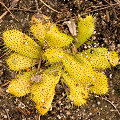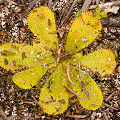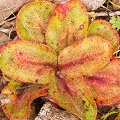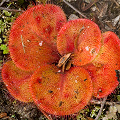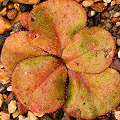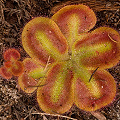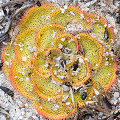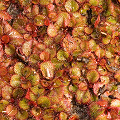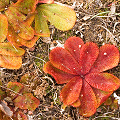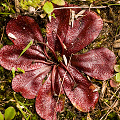Q: The tuberous rosetted Drosera
| The Tuberous Rosetted Drosera1 | |
|---|---|
|
D. aberrans2,3 D. browniana D. bulbosa subsp. bulbosa D. bulbosa subsp. coronata D. collina D. erythrorhiza D. lowriei D. macrophylla D. magna D. major D. monantha |
D. orbiculata D. praefolia2,3 D. prostratoscaposa D. rosulata D. schmutzii3 D. squamosa D. tubaestylis D. whittakeri3 D. zonaria |
|
1All in Drosera section Erythrorhiza 2Previously lumped into D. whittakeri. 3Found in the eastern part of Australia. |
|
A: Now for the tuberous Drosera,
perhaps the most highly modified of the entire genus. Tuberous Drosera mostly live in
Western Australia (with a few exceptions), and must contend with the
same seasonal variations that confront the pygmy sundews. To recapitulate, they have a cool and moist winter growing season and a
long, hot, dry summer season. While the pygmy sundews hide from the summer heat in little stipule buds, the above-ground parts of
tuberous Drosera die back completely. Furthermore, they translocate all their valuable
reserves of water and photosynthates into small, more or less spherical underground tubers. They spend the summer months in tuber
form, and emerge in the spring to produce their rosettes of leaves and flowers.
There are three groups of tuberous Drosera, as reflected by the genus sectional divisions. On this page
I give an overview of all the tuberous species, but focus on the group called the rosetted species, i.e., those classified in
section Erythrorhiza.
Some tuberous Drosera are enormous. You might expect as much from an erect species
called D. gigantea, but even some of the rosetted species are big,
as you might infer from the name "D. magna!"
Drosera bulbosa
This species ia a somewhat small species, but has (in all the plants I have seen in the wild and cultivation) bright green leaves
that are not quite matched by any of the other species. The gland heads are particularly large and striking.
It's funny, but many times tuberous rosetted sundews bear the indications of a lot of abuse. The leaves are torn up, and in
particular the glandular hairs are usually laying down, exhausted, without mucus. I've not seen this to be the case with
Drosera bulbosa subsp. bulbosa--they
always look like sundews!
Drosera erythrorhiza
This plant is a good ambassador
for the group. In the past it was described as having four
subspecies, based mostly upon leaf shape characters and range, but then these have been sent to their own species!
Drosera erythrorhiza
has relatively few, wide leaves.
Drosera collina
This species has many leaves of varying shapes.
Drosera magna
These plants have very large leaves in somewhat greater number than
Drosera erythrorhiza.
Drosera rosulata
A relatively small species, and the one that was most common when I visited Western Australia. But it was very pretty, ranging in
color from dark green to nearly crimson-black. Seeing the ground spangled with variously colored plants was thrilling.
Drosera squamosa
I am particularly fond of this species. Its striking leaves are banded with bold red zones, due to the tentacle coloration.
Drosera tubaestylis
A species similar to Drosera rosulata, but which can be distinguished on technical details such as the
nature of the midrib. This plant is usually very clonally reproductive, and forms large colonies of plants.
Drosera zonaria
A very interesting species with many overlapping leaves, grading in size from large (on the outer edge) to quite small
(near the rosette center). I've always seen this in sand, and not in laterite.
The tuberous Drosera have garnered a surprising amount of controversy in carnivorous plant
circles. First, there is the name: "tuberous". Some botanists argue that these plants produce corms, and not tubers.
The distinction rests in part upon the fact that in true tubers such as the potato, the leaves (if present) do not
cover the swollen tuberous structure, while in corms the old leaves form enclosing papery sheaths, as in the genus
Crocus.
Meanwhile, Conran (2008) has concluded that the term tuber is more appropriate after all.
I admit that I have grown tired of this discussion, and have decided that regardless of
whether they are truly tubers or corms, the common name for these plants has become "tuberous sundews." I note that
plants in the genus Byblis are sometimes called "rainbow plants," but no one seems to care
that they are not really made out of rainbows.
Another source of vitriolic argument is in the classification of these plants. Books and papers by Allen Lowrie and his coworkers
established many names for tuberous species. Other scientists subsquently reclassified these names,
sometimes establishing new species, sometimes lumping plants together, or sometimes
by changing infraspecific status (like subspecies to variety). I encourage you to review the original publications and
draw your own conclusions. Refer to my citation lists, at the bottom of each FAQ page.
Before I describe cultivation, let me quickly describe the structure of a tuberous sundew when it is in full growth. First, there are the leaves
and flowers above ground. Then, there is a tuber, perhaps 10cm (4 inches) or even much further below ground. Tubers are either pale white,
pink, or bright red, and are about the size of a pea. (Tubers from old D. erythrorhiza can be much larger,
while those of seedlings that germinated late in the season can be very small.) Finally, there is a long, usually vertical shoot that
connects the tuber to the soil surface.
All tuberous sundews (rosetted, erect, fan-leaved) can be grown with reasonable success if you pay attention to giving them the long growing season
they want, and a proper dormancy. You will probably not be successful starting plants from seed unless you are trying the erect
species D. peltata. While these plants grow readily from seed,
they are exceptions to what you should expect from the other tuberous species which may require heroic actions like
fire, smoke disks, or gibberellic acid. If you start with tubers, it would be best if you had tubers from the same hemisphere
as you. That means that if you are in Europe, try to get tubers from other northern hemisphereans. If you start with tubers imported
from Australia, expect a high failure rate as the tubers try to acclimate to the 6-month jet lag.
I suggest you use very deep pots (15cm, 6 inches), with a 2:1 sand:peat mix. Keep the pots barely moist until the growth appears
above ground, then grow the plant in normal wet carnivorous plant conditions. Watering by tray is fine, but keep the water level below
the tuber-depth, otherwise you might drown the tubers. The plants respond well to a foliar
application of a full-strength acid fertilizer, sprayed three or so times during the growing season. Spray them with the mix until
the plants are dripping wet.
When the plants stop growing and die back (usually after flowering) let the pots dry out. Do not disturb the soil since the plant
is slowly relocating its resources from the leaves and stems to the underground tuber via the vertical underground shoot. Do not disturb
the tuber for a few months, even though all the leaves and stem can be completely dead, since the vertical shoot
might still be alive.
I like to see what the tuber looks like at the end of the year, so I usually dig into the soil during dormancy. I find it
instructive to see how deep in the pot the tuber is, how large it is, if it has made a daughter tuber, etc. For this reason, I never use
aggregate in the media (like perlite, pumice, or gravel) because it would drive me insane trying to find the little tubers amongst the
rock chunks. When I poke around in the soil at the end of the year, I also keep an eye out for earthworms. I strongly believe
that some worms will attack the tubers for food when nothing else is around.
How dry should the pot be during dormancy? I hear that question posed a great deal. Do not let the tubers dry out completely.
Many sources of cultural information suggest letting the plants go "bone dry," but if you
have lived in a desert climate like I have, you might easily overdo this.
I think the best solution is for you to keep the pot in your growing area,
but simply withhold water. If you grow plants in a greenhouse, take them out of watering trays. If you grow your plants in a terrarium,
raise the pots out of the water. That general rule works well for me.
Propagation is best done by hoping for the occasional production of a "daughter" tuber. In my
limited experience with only about 20 species, only D. auriculata,
D. peltata and D. ramellosa readily produce easily germinable
seed.
The cultivation guidelines on this page should do well for you, and should enable you to grow at least the easier species like
D. peltata. If you want to learn more about these plants, you really should get copies of Lowrie's
books. Some of the species names might have changed, but Lowrie's books are absolutely invaluable for figuring out how to grow
the plants. And they will tell you about some species which flower before make leaves, or ones that have shoots that bend
horizontally before emerging at the soil surface, and will explain how some species relocate their tubers
year after year. And, of course, much more.
Page citations: Conran, J.G. 2008; Lowrie, A. 1987, 1989, 1999, 2005, 2013;
Lowrie, A., and Conran, J.G. 2008; Lowrie, A. et al. 2017a, 2017b;
Rice, B.A. 2006a; Robinson, A. et al. 2017;Schlauer, J. 1996, 2002; Taton, A. 1945.
